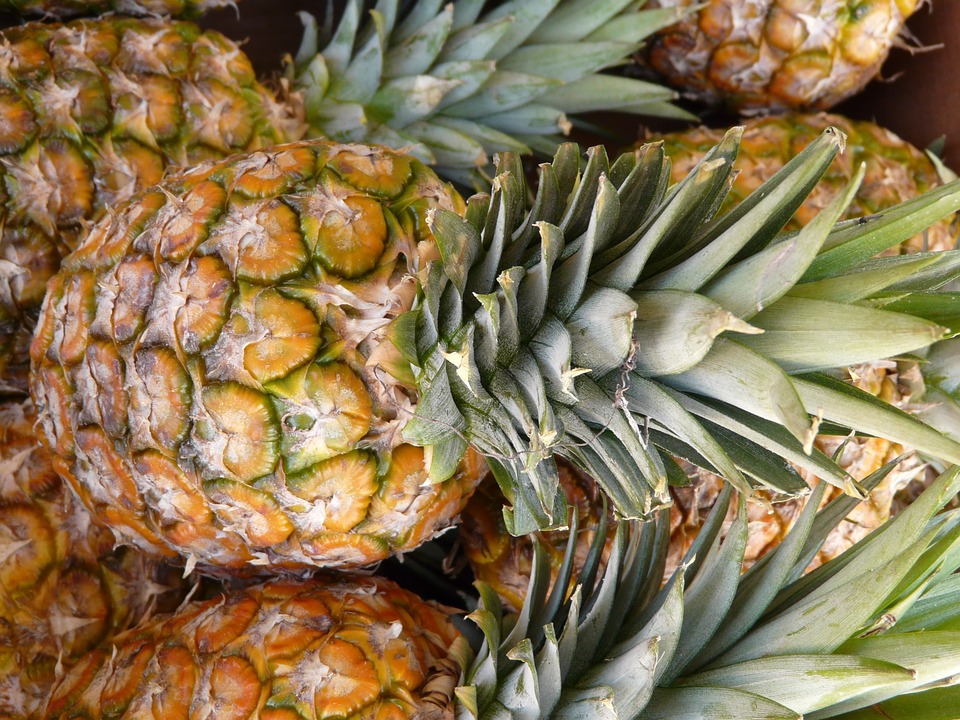As a dog owner, I'm always looking for ways to make my furry friend happy, and what's better than a tasty treat? But when it comes to sharing our food with our canine companions, we need to be careful. One fruit that often sparks debate is pineapple. So, can dogs eat pineapple? Well, the answer, as with most things in dog ownership, is a bit more nuanced than a simple yes or no.
Part 1: The Sweet Truth About Pineapple

Pineapple, with its juicy, tangy sweetness, is a favourite fruit for many humans. But can our dogs enjoy it too? The good news is that pineapple, in moderation, is generally safe for dogs to eat. But there are some important things to keep in mind.
1.1. A Nutritional Powerhouse
Pineapple isn't just delicious; it's a powerhouse of nutrients. It's a good source of vitamins C and B6, manganese, and bromelain. Bromelain is a digestive enzyme that's been linked to potential anti-inflammatory benefits. Now, these nutrients are generally considered safe for dogs, but it's important to remember that their bodies process things differently than ours.
Here's a breakdown of the nutritional benefits of pineapple for dogs:
- Vitamin C: An essential antioxidant that supports immune function, collagen production, and wound healing.
- Vitamin B6: Plays a crucial role in metabolism, brain function, and red blood cell production.
- Manganese: Supports bone health, cartilage formation, and energy production.
- Bromelain: A digestive enzyme that aids in breaking down proteins, potentially reducing inflammation.
1.2. The Potential Pitfalls
While pineapple can be a tasty treat for your dog, there are a few things to watch out for. First, the core and rind are tough and potentially harmful. They can cause choking or digestive upset. Second, the high sugar content in pineapple can lead to weight gain or other health issues if given in excess. It's best to treat pineapple as an occasional treat, not a regular part of your dog's diet.
Here's a closer look at the potential downsides:
- Choking Hazard: The tough core and rind of pineapple can be difficult for dogs to chew and can pose a choking risk.
- Digestive Upset: The high acidity of pineapple can irritate a dog's stomach, leading to vomiting, diarrhea, or gas.
- Weight Gain: Pineapple is high in sugar, and excessive consumption can contribute to weight gain, especially if your dog is prone to obesity.
- Allergies: While rare, some dogs can be allergic to pineapple, resulting in symptoms like itching, swelling, or difficulty breathing.
Part 2: The Dos and Don'ts of Pineapple for Dogs

Now that we know pineapple can be a treat, let's get into the specifics of how to safely share it with our pups.
2.1. The Dos
- Choose fresh pineapple: Opt for fresh pineapple over canned, as canned pineapple often contains added sugars and preservatives that are not good for your dog. Fresh pineapple provides a more natural and less processed option.
- Remove the core and rind: These parts are difficult to digest and can pose a choking hazard. Always remove them before giving pineapple to your dog.
- Start with a small amount: Introduce pineapple gradually and observe your dog for any signs of adverse reactions. Start with a tiny piece and increase gradually as your dog tolerates it.
- Wash thoroughly: Always wash the pineapple before giving it to your dog to remove any pesticides or contaminants.
2.2. The Don'ts
- Don't give pineapple to puppies or dogs with digestive issues: Puppies and dogs with sensitive stomachs are more likely to experience digestive upset from pineapple. It's best to consult with your veterinarian before giving pineapple to young or sensitive dogs.
- Don't give pineapple as a regular treat: Treat pineapple as a rare treat, not a regular part of your dog's diet. Too much pineapple can lead to health problems like weight gain and digestive issues.
- Don't give large chunks of pineapple: Break the pineapple into small, bite-sized pieces to prevent choking. Make sure your dog can easily chew and swallow the pieces.
- Don't give pineapple to dogs with allergies: Some dogs are allergic to pineapple, so it's important to watch for any signs of allergic reaction, such as itching, swelling, or difficulty breathing. If you see any signs of an allergic reaction, stop giving your dog pineapple and contact your veterinarian.
Part 3: My Pineapple Journey with My Dog

I've always been a bit hesitant about sharing my pineapple with my dog, Buster. He's a curious little guy, and I've seen him scarf down some questionable things! But, I decided to give pineapple a try. I carefully removed the core and rind, washed the fruit thoroughly, and gave him a small piece. To my surprise, Buster loved it! He gobbled it down in seconds and seemed to enjoy the taste.
Of course, I didn't go overboard. I only gave him a small piece, and I observed him closely afterwards for any signs of digestive upset. Fortunately, everything went smoothly, and Buster didn't have any problems. Now, I give him a small piece of pineapple every few weeks as a special treat, and he always looks forward to it. It's become a little ritual that we both enjoy.
My experience with Buster highlights the importance of introducing new foods gradually and observing your dog's reaction. If you see any signs of trouble, stop giving pineapple and consult with your veterinarian.
Part 4: Understanding Your Dog's Reactions
Every dog is different, and what works for one dog may not work for another. It's essential to observe your dog closely after introducing pineapple to see how they react. Here are some signs to watch out for:
4.1. Signs of Digestive Upset
- Diarrhea: This is a common sign of digestive upset in dogs. Pineapple can be a bit harsh on some dog's stomachs, especially if they're not used to eating it.
- Vomiting: Vomiting can also be a sign of digestive upset or an allergic reaction. If your dog vomits after eating pineapple, it's best to stop giving it to them and consult with your veterinarian.
- Gas: Pineapple can cause gas in some dogs, especially if they're not used to eating it. If your dog is experiencing excessive gas, it may be a sign that they're not tolerating pineapple well.
- Stomach cramps: Your dog may show signs of stomach cramps, such as restlessness or pacing. If your dog is exhibiting these symptoms, it could be a sign that they're experiencing discomfort from the pineapple.
4.2. Signs of an Allergic Reaction
- Itching or hives: These are common signs of an allergic reaction in dogs. If your dog starts to itch or develop hives after eating pineapple, it's a sign they may be allergic to it.
- Swelling: Swelling of the face, lips, or tongue can also be a sign of an allergic reaction. If you notice swelling in your dog, it's important to seek veterinary attention immediately.
- Difficulty breathing: If your dog is having trouble breathing, this could be a serious allergic reaction and you should seek veterinary attention immediately. This is an emergency situation, so don't hesitate to call your veterinarian or rush your dog to the nearest emergency clinic.
If you notice any of these signs, stop giving your dog pineapple and consult your veterinarian. They can help determine if your dog has a sensitivity to pineapple or if there's a more serious issue.
Part 5: Pineapple Alternatives for Dogs
If your dog doesn't seem to enjoy pineapple or you're hesitant to give it to them, there are plenty of other delicious and safe treats you can offer. Some great fruit alternatives include:
5.1. Fruits That Are Safe for Dogs
- Bananas: These are a good source of potassium and fibre. Bananas can be a healthy treat for dogs and are generally well-tolerated.
- Apples: Apples are packed with vitamins and antioxidants, but make sure to remove the core and seeds before giving them to your dog. The core and seeds contain cyanide, which is toxic to dogs.
- Blueberries: These little berries are high in antioxidants and can be a healthy treat for your pup. Blueberries are also low in calories and sugar, making them a good choice for dogs who are watching their weight.
- Strawberries: Strawberries are a good source of vitamin C, but make sure to remove the leaves before giving them to your dog. The leaves can be toxic to dogs, so it's important to remove them before offering strawberries as a treat.
5.2. Beyond Fruit
Beyond fruits, you can also find many dog-friendly treats at your local pet store. These treats are often made with healthy ingredients like peanut butter, sweet potato, and pumpkin. They are also a good option for dogs with allergies or sensitivities.
When choosing commercial dog treats, it's essential to check the ingredients and make sure they are safe and healthy for your dog. Avoid treats that contain artificial colours, flavours, or preservatives.
Part 6: The Importance of Moderation
The key to sharing treats with your dog is moderation. Even the healthiest treats can be harmful if given in excess. Pineapple is no exception. It's essential to remember that treats should make up a small percentage of your dog's overall diet. Their primary food source should be a balanced and nutritious dog food.
Here are some tips for incorporating treats into your dog's diet:
- Use treats as rewards for training or good behaviour. This helps to reinforce positive behaviour and keeps your dog engaged.
- Limit treats to no more than 10% of your dog's daily caloric intake. This ensures that treats don't contribute to weight gain.
- Choose treats that are low in sugar and fat. Look for treats that are made with whole, natural ingredients.
- Break up large treats into smaller pieces. This helps to prevent choking and makes it easier for your dog to digest the treat.
Part 7: Consult Your Vet
If you have any concerns about giving your dog pineapple or other treats, it's always best to consult with your veterinarian. They can advise you on the best treats for your dog, based on their individual needs and health conditions.
Your veterinarian can also help you determine the appropriate amount of treats to give your dog based on their age, breed, activity level, and overall health. They can also advise you on which treats are best suited for your dog's specific needs.
Part 8: FAQs
8.1. Can dogs eat pineapple skin?
No, it is not safe for dogs to eat pineapple skin. It's tough and difficult to digest, and it can cause choking or digestive upset. The skin also contains enzymes that can irritate your dog's mouth and stomach.
8.2. Can dogs eat pineapple juice?
While pineapple juice is generally safe for dogs in small amounts, it's best to stick to fresh pineapple as it is a more natural option without added sugar or preservatives. Pineapple juice often contains added sugar and preservatives, which are not good for dogs.
8.3. Is pineapple good for dogs' teeth?
Pineapple is not known to have any particular benefits for dog teeth. It's best to stick to dog-specific dental treats or chew toys designed to promote healthy teeth. These products are specifically formulated to help remove plaque and tartar, which are the main causes of dental problems in dogs.
8.4. Can dogs eat pineapple every day?
No, it's not recommended to give dogs pineapple every day. Too much sugar and the concentrated form of bromelain could cause digestive upset or other health issues. Pineapple should be given as an occasional treat, not a regular part of your dog's diet.
8.5. My dog ate a whole pineapple core. Should I be worried?
If your dog ate a whole pineapple core, it's best to contact your veterinarian immediately. They can assess the situation and advise you on what to do next. The core is tough and difficult to digest, and it could cause a blockage in your dog's digestive system.
Giving your dog pineapple can be a fun way to share your love for this tropical fruit, but remember to do so responsibly. Always choose fresh pineapple, remove the core and rind, start with a small amount, and observe your dog closely for any signs of adverse reactions. Most importantly, remember that pineapple is a treat, not a meal. Ensure your furry friend has a balanced and nutritious diet. With a little care and consideration, you can enjoy the sweet taste of pineapple with your canine companion.
Everyone is watching
-

Can Dogs Eat Bananas? A Guide to Safe Treats
DOGS & PUPPIESThis comprehensive guide will delve into the world of canine nutrition, focusing on the popular question: can ...
-

Can Dogs Eat Oranges? (Is It Safe or Toxic?)
DOGS & PUPPIESThis article delves into the question of whether dogs can safely consume oranges. We'll explore the nutrition...
-

Can Dogs Eat Grapes? The Shocking Truth About This Fruit
DOGS & PUPPIESThis article delves into the controversial topic of grapes and dogs, exploring the potential dangers associate...
-

Why Do Dogs Eat Poop? Understanding Coprophagia in Dogs
DOGS & PUPPIESThis article delves into the perplexing phenomenon of coprophagia, the act of eating faeces, in dogs. We explo...
-

Can Dogs Eat Shrimp? A Guide to Safety and Risks
DOGS & PUPPIESThis comprehensive guide dives into the world of shrimp and dogs, exploring the potential benefits and risks a...
